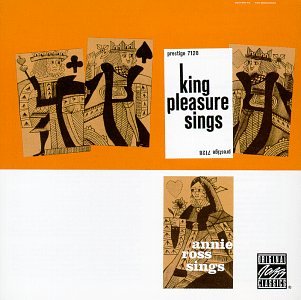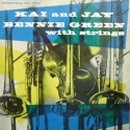What did 1954 in jazz look like?
I wonder if jazz has a sort of an ongoing death wish. What's that you say? Jazz is the most popular form of music in America? I know! We'll change it! We'll invent a new kind of jazz that nobody likes! Wait...what's that you're saying now? People are getting used to bebop? It's getting popular again? They're using it in movie and TV scores? We can't have that. Let's invent something that absolutely no one understands.
But in the mid-Fifties, we were sort of between self-destructs. No one was quite ready for Birth of the Cool, but that's OK, Capitol had put it on the shelf, and wouldn't be re-releasing it for another couple of years.
But look what was happening.
Playboy had begun publication in 1953, with an article on the Dorsey Brothers in its inaugural issue, and Hefner would continue to promote jazz to a mass audience. Mort Sahl described
Playboy as a magazine devoted to sports cars and seduction. "The sports cars are in the front, under 'Science,' and the other...science fiction?" He could have added jazz under "Art," but that would have killed the joke, jazz actually being an important art form and all.
Jazz wasn't entirely recognized in America yet, but it certainly was in Europe. Benny Goodman and Louis Armstrong became worldwide ambassadors to Europe and beyond -- Armstrong made his first tour of Japan in 1954, and Goodman would soon become the first jazzman to duet with the jazz-loving King of Thailand. But it wasn't just the traditionalists. An odd offshoot of the Cold War was the CIA's theory that one weapon in the West's arsenal would be avant grade art, since the socialist realists behind the Iron Curtain hated it. So through liberal front organizations, they sponsored abstract expressionist painting, even though they probably mostly hated it in private, and...modern jazz. Dizzy Gillespie was another jazz ambassador sent off on world tours, and if it took the Europeans a little while to appreciate the moderns, they caught on a lot more quickly than the Americans did.
One of the big jazz tours of 1954 was Lionel Hampton's, and while Hamp wasn't exactly a bebopper, or even particularly sympathetic to bebop, he had a history of hiring musicians with a modern bent. His great proto-rhythm and blues bands of the 1940s had future beboppers including Johnny Griffin and Charles Mingus. And the Prestige catalog for 1954 is full of recordings by that year's touring Hampton band.
Bebop was turning into hard bop, which was pretty much the same music, except with a little more recognition of the possibility that people might actually like it.
But perhaps the two biggest moves toward developing a new jazz audience in 1954 were when jazz, in the person of a certain Mr. Brubeck, went to college, and when jazz invaded high society as George Wein staged the first Newport Jazz Festival. Here’s the complete lineup for that first fest:
SATURDAY NIGHT, JULY 17, 1954
Prologue – STAN KENTON
EDDIE CONDON:
Traditional Jazz with Wild Bill Davidson, Lou McGarrity, Peanuts Hucko, Ralph Sutton, Cliff Leemans, Bobby Hackett, Pee Wee Russell, Vic Dickenson, Bud Freeman, Jo Jones, Milt Hinton
LEE WILEY
MODERN JAZZ QUARTET:
Milt Jackson, Kenny Clark, Percy Heath, Horace Silver
OSCAR PETERSON with Ray Brown, Herb Ellis
BILLIE HOLIDAY
DIZZY GILLESPIE QUINTET:
Wade Legge, Charlie Persip, Lew Hackney, Hank Mobley
GERRY MULLIGAN QUARTET:
Red Mitchell, Frank Isola, Tony Frisee
SUNDAY NIGHT, JULY 18
Introduction: STAN KENTON
TRIBUTE TO COUNT BASIE:
Lester Young, Buck Clayton, Vic Dickenson, Jo Jones, Milt Hinton, Teddy Wilson
OSCAR PETERSON TRIO
JOHNNIE SMITH
DIZZY GILLESPIE QUINTET
BILL HARRIS
GEORGE SHEARING QUINTET:
Al McKibbon, Bill Clarke, Jon Thielmans, George Devens
ERROL GARNER:
Jo Jones, Milt Hinton
LENNIE TRISTANO, LEE KONITZ:
Billy Bauer, Peter Ind, Jeff Morton
GENE KRUPA TRIO:
Teddy Napoleon, Eddie Shu
ELLA FITZGERALD:
John Lewis, Jimmy Woode, Shadow Wilson
The lineup for the MJQ is interesting...Horace Silver? But apparently John Lewis was busy at the time, backing up Ella Fitzgerald.
Of course, you may go to college, and you may go to school, and you may drive a pink Cadillac but you may still have history running against you if in the same year that your music is beginning gain in popularity, a kid named Elvis Presley releases his first record.
Well, you can't have everything. Jazz is still looking pretty good in 1954.
Here is the list of the top albums of 1954 from rateyourmusic.com -- as usual, it's an eccentric list, but an interesting one. I've cut out the non-jazz albums, but jazz, as always, figures high with the rateyourmusic folks. I've just put in a few notes here and there.
1
Clifford Brown and Max Roach (EmArcy)
- This became a group of legend, and an album of legend, because of Brownie's untimely death, so it may rank higher now than it would have then, but it would have ranked pretty high then. Everyone always knew how good they were.
2
A Night at Birdland, Vol. 1 --Art Blakey Quintet (Blue Note)
3
Louis Armstrong Plays W. C. Handy (Columbia)
4
Chet Baker Sings (Pacific Jazz)
- No one much liked this when it came out. The consensus was that it should have been Chet Baker Plays, and otherwise shuts up. But in the intervening years it's developed a cult following. Maybe I should listen to it again. Geoff Dyer, in his book of meditations on jazz and jazz musicians, suggests that because Chet Baker was completely soulless, his music had a purity that could touch the soul of any listener. And I suspect that's easier to do with an instrument than with a voice.
5
The Amazing Bud Powell, Vol. 2 (Blue Note)
6
A Night at Birdland, Vol. 2 --Art Blakey Quintet (Blue Note)
7
Dinah Jams --Dinah Washington (EmArcy)
- This is one of my favorite vocal albums ever. It's got Brown and Roach, and Harold Land and Maynard Ferguson and Clark Terry and more, and Dinah really does jam with them, as few vocalists can jam.
9
Songs for Young Lovers -- Frank Sinatra (Capitol)
- It was the accepted wisdom back in the Fifties that Sinatra could have been a real jazz singer if he'd challenge himself, and work with real jazz musicians, well, later on, when he started Reprise, his own label, he did record with musicians like Count Basie. But ask anyone what's the best Sinatra - Columbia, Capitol, or Reprise - and you'll get the same answer nine times out of ten: Capitol. Sinatra was a real jazz singer in the Fifties, and the Nelson Riddle arrangements gave him the flexibility to do his best work.
13
Lester Young With The Oscar Peterson Trio (Norgran)
14
The Consummate Artistry of Ben Webster (Norgran)
15
Jazz Goes to College --The Dave Brubeck Quartet (Columbia)
- If this were a list of the most influential albums of the year, this one would have a strong claim on Number One. Brubeck set out to find a new audience for jazz, and he found it. Or created it.
17
Afro Dizzy Gillespie (Norgran)
18
Images --Sarah Vaughan (EmArcy)
- I would have thought this had come earlier. It has what may be the quintessential bebop vocal, "Shulie a Bop," the one in which she introduces the members of her band, including "Roy (drumroll) ... Haynes (drumroll)."
19
Something Cool --June Christy (Capitol)
22
Piano Solo --Thelonious Monk( Swing)
23
Swing Easy! --Frank Sinatra (Capitol)
25
Songs in a Mellow Mood --Ella Fitzgerald (Decca)
26
After Hours With Miss D --Dinah Washington (EmArcy)
28 C
hris Connor Sings Lullabys of Birdland (Bethlehem)
29
Thelonious Monk Quintet Blows for LP (Prestige)
34
Chet Baker and Strings (Columbia)
35
Jazz at College of the Pacific --The Dave Brubeck Quartet (Columbia)
38
Lester Young With The Oscar Peterson Trio (Norgran)
40
Lennie Niehaus Vol.1 The Quintets (Contemporary)
41
A Night at Birdland, Vol. 3 --Art Blakey Quintet (Blue Note)
44
Kenny Dorham Quintet (Debut)
47
Billie Holiday at Jazz at the Philharmonic (Clef)
48
Blakey (Fontana)
50
Pleyel Concert, Vol. 1 -- Gerry Mulligan (Vogue)
I’m still waiting on
Down Beat to create a complete digital archive of its back issues, so I can get a better sense of what’s happening at a given moment in jazz. The New Yorker continues to shy away from modern jazz in its club listings, but we do know that as the year ends Errol Garner is at The Embers; Basin Street has Duke Ellington, Don Shirley and Roy Hamilton; George Shearing and Tito Puente share billing at Birdland; and Marian McPartland is at Hickory House. Jorie’s Purple Onion is primarily a showcase for comedian Jorie Reimes, but Jackie and Roy are also on the bill.
Billboard didn't cover a whole lot of jazz, and their year-end Disc Jockey Poll mostly reached out to DJs like Jack Lacy--not the sort that played a whole of Bird, Pres, Shearing or Count Basie. Their idea of the top jazz albums of the year:
Which tells you, among other things, that even among the Listening to Lacy set, Brubeck was making a major impact.
Here are their choices for best small instrumental combo, and here some more jazz starts nudging out some of the easy listening:
Looking further into the Disc Jockey Poll for 1954, one finds some interesting stuff, starting with this bit of difference between DJs then and DJs now:
Who selects the records played on your show?
- Myself 492
- Program manager 1
- Music librarian 9
- Assistant 1
And this does strike me as interesting, if mildly off the subject, because I would have thought that the death knell had pretty much been rung for 78s by this time.
What record speed is your station equipped to play?
Billboard's chief interest was in the business end of the music business, so this article, in the same year-end wrapup issue, gives a pretty good insight into how the jazz business was coming along. There was even the possibility of...binaural jazz!
In the
AllAboutJazz timeline for the year, heroin unfortunately continues to be a main part of the jazz story. Miles Davis has kicked addiction, and returned to the recording studio. But Sonny Rollins has decided he needs to take a break from playing, and try to kick his habit. John Coltrane has just been Johnny Hodges for drug use, and he retreats into the rhythm and blues scene, playing for, among others, Jimmy Smith and Big Maybelle, who announces to the audience in the middle of a set that Coltrane is her favorite musician.
And here are the
Down Beat Readers' Poll winners for the year:
Hall of Fame: Stan Kenton
Personalities of the Year-Popular: Frank Sinatra, Rosemary Clooney
Personalities of the Year-Jazz: Dave Brubeck
Personalities of the Year-Latin American: Perez Prado
Personalities of the Year-Rhythm & Blues: Ruth Brown
Dance Band: Les Brown
Jazz Band: Stan Kenton
Combo-Instrumental: Dave Brubeck
Vocal Group: Four Freshmen
Alto Saxophone: Charlie Parker
Tenor Saxophone: Stan Getz
Baritone Saxophone: Gerry Mulligan
Trumpet: Chet Baker
Trombone: Bill Harris
Clarinet: Buddy DeFranco
Drums: Shelly Manne
Vibes: Terry Gibbs
Bass: Ray Brown
Guitar: Johnny Smith
Piano: Oscar Peterson
Accordion: Art Van Damme
Miscellaneous Instrument: Don Elliot-Mellophone
Arranger: Pete Rugolo
Male Singer (Not Band): Frank Sinatra
Girl Singer (Not Band): Ella Fitzgerald
Male Singer (With Band): Tommy Mercer
Girl Singer (With Band): Lucy Ann Polk




:format(jpeg):mode_rgb():quality(96)/discogs-images/R-2873252-1320399681.jpeg.jpg)
:format(jpeg):mode_rgb()/discogs-images/R-6313898-1416239716-9087.jpeg.jpg)













:format(jpeg):mode_rgb():quality(96)/discogs-images/R-4076578-1354790180-3149.jpeg.jpg)

:format(jpeg):mode_rgb():quality(96)/discogs-images/R-2205394-1269729515.jpeg.jpg)
:format(jpeg):mode_rgb():quality(96)/discogs-images/R-5126683-1385223126-8867.jpeg.jpg)
:format(jpeg):mode_rgb()/discogs-images/R-2767744-1367732273-6848.jpeg.jpg)



